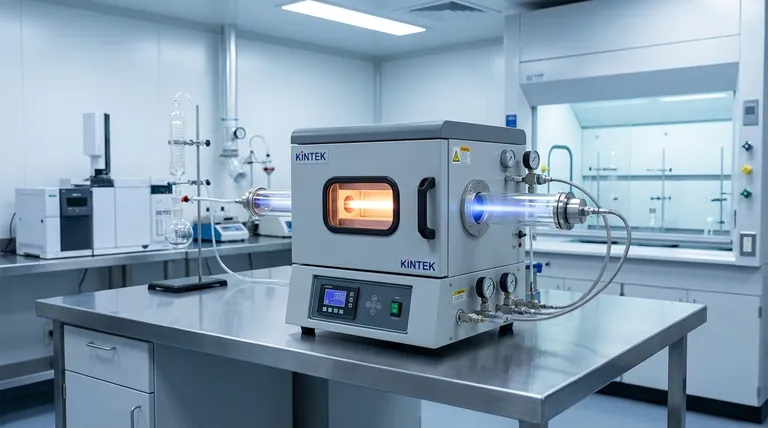At its core, a CVD lab-grown diamond is a real diamond created in a laboratory using a process called Chemical Vapor Deposition. This method "grows" a diamond from a tiny seed crystal by placing it in a vacuum chamber and exposing it to carbon-rich gases at extremely high temperatures. The gases ionize and their carbon atoms attach to the seed, building up the diamond layer by layer over several weeks.
The critical takeaway is that CVD is a sophisticated manufacturing process, not a compromise on substance. It produces a genuine diamond that is chemically, physically, and optically identical to one mined from the earth.

How the CVD Process Works: A Layer-by-Layer Creation
The CVD method builds a diamond atom by atom, mimicking a process that happens in interstellar gas clouds rather than deep within the Earth.
The Diamond "Seed"
The entire process begins with a minuscule, high-quality slice of a pre-existing diamond. This slice, often called a diamond seed, acts as the foundation upon which the new diamond will grow.
The Vacuum Chamber Environment
This seed is placed inside a sealed vacuum chamber. The chamber is then filled with a specific mixture of carbon-heavy gases, such as methane, and heated to extremely high temperatures.
From Carbon Gas to Crystal
The intense heat energizes the gas into a plasma, causing carbon atoms to separate from their gas molecules. These free carbon atoms then rain down and bond to the diamond seed, meticulously building new crystalline layers and growing a larger, gem-quality diamond.
CVD vs. Other Diamonds: Understanding the Distinctions
While visually identical to the naked eye, CVD diamonds have distinct origins and characteristics when compared to both natural and other lab-grown diamonds.
CVD vs. Natural Mined Diamonds
The only difference is their origin. One is formed in a lab, the other deep within the Earth. They are both made of pure carbon crystallized in an isometric system.
A strong, though not definitive, indicator is the diamond's classification. Most CVD diamonds are Type IIa, a category representing the most chemically pure diamonds, which accounts for less than 2% of all natural diamonds.
CVD vs. HPHT Lab-Grown Diamonds
HPHT (High Pressure/High Temperature) is the other primary method for creating lab-grown diamonds. It mimics the Earth's natural process by subjecting solid carbon to immense pressure and heat.
CVD, by contrast, relies on gas deposition in a low-pressure environment. There is no inherent quality difference between the two methods; both produce high-quality gems, and manufacturers choose a process based on their specific needs and goals.
Understanding the Trade-offs and Considerations
Choosing a CVD diamond involves weighing its unique advantages against potential long-term uncertainties.
Potential for a Hazy Appearance
The plasma used during the CVD growth process can sometimes result in a subtle hazy, milky, or oily appearance. While often imperceptible, this can be seen under high magnification by a trained gemologist.
The Question of Long-Term Value
The primary concern for the CVD market is the uncertainty of its long-term value. As technology improves, production becomes more efficient, which may reduce future prices. Their mass-production capability means they lack the inherent rarity of natural diamonds.
Quality is Not Process-Dependent
It is crucial to understand that the final quality of any diamond—whether CVD, HPHT, or natural—depends on the specifics of its creation and subsequent cutting and polishing, not on the method alone.
Making the Right Choice for Your Goal
Your final decision should be guided by your personal priorities, whether they are budget, investment potential, or ethical considerations.
- If your primary focus is obtaining the largest, highest-quality diamond for your budget: A CVD diamond offers a chemically identical alternative to a mined diamond, often at a significantly lower price point.
- If your primary focus is long-term investment and guaranteed rarity: The price uncertainty of manufactured diamonds makes a high-quality natural diamond a more traditional and stable choice.
- If your primary focus is a traceable and controlled origin: The laboratory environment of a CVD diamond provides a clear, documented history that is difficult to achieve with mined diamonds.
Ultimately, understanding the science behind a CVD diamond empowers you to choose a stone that perfectly aligns with your own values and goals.
Summary Table:
| Aspect | CVD Lab-Grown Diamond | Natural Mined Diamond | HPHT Lab-Grown Diamond |
|---|---|---|---|
| Composition | Pure Carbon (Chemically Identical) | Pure Carbon (Chemically Identical) | Pure Carbon (Chemically Identical) |
| Formation Process | Chemical Vapor Deposition (Gas) | Geological (Earth's Mantle) | High Pressure/High Temperature (Solid Carbon) |
| Typical Purity | Often Type IIa (High Purity) | Rarely Type IIa (<2%) | Varies |
| Primary Consideration | Cost-Effective, Traceable Origin | Rarity, Traditional Value | Similar Quality, Different Method |
Need precise, reliable equipment for material science research like CVD? KINTEK specializes in high-quality lab equipment and consumables, serving laboratories that require advanced technology for consistent, accurate results. Whether you're growing diamonds or developing new materials, our solutions support your innovation. Contact our experts today to find the perfect equipment for your lab's needs!
Visual Guide

Related Products
- Customer Made Versatile CVD Tube Furnace Chemical Vapor Deposition Chamber System Equipment
- Chemical Vapor Deposition CVD Equipment System Chamber Slide PECVD Tube Furnace with Liquid Gasifier PECVD Machine
- Cylindrical Resonator MPCVD Machine System Reactor for Microwave Plasma Chemical Vapor Deposition and Lab Diamond Growth
- Microwave Plasma Chemical Vapor Deposition MPCVD Machine System Reactor for Lab and Diamond Growth
- CVD Diamond for Thermal Management Applications
People Also Ask
- How high of temperature do carbon nanotubes in air have the ability to sustain? Understanding the Oxidation Limit
- Why are carbon nanotubes important in industry? Unlocking Next-Generation Material Performance
- What are the methods of producing CNT? Scalable CVD vs. High-Purity Lab Techniques
- Are all lab grown diamonds CVD? Understanding the Two Main Methods
- What is the floating catalyst method? A Guide to High-Yield CNT Production



















